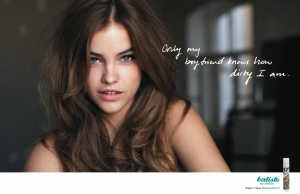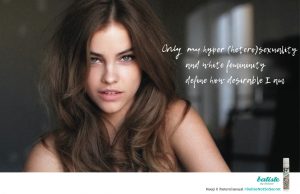
Original Ad Analysis
Despite its playful attempt, there are an array of intersectional issues present in the above #BatisteSecret ad campaign. First, the advertisement relies on oversexualization to sell their product. Notably, the model used in the ad is intentionally made up to portray a “conventional sense of [sexiness]” with long, tousled hair, a provocative facial expression, and implied nakedness (Naik & Chhabra, 2018, p. 23). The ad provocatively suggests that the model is “dirty” through its use of a sexual double entendre and further comments that she “keep it clean” with Batiste. The implicit messages behind this assertion are two-fold: first, the oversexualization of the model to signal the product’s attractiveness ultimately promotes the notion that women must be overtly and conventionally sexy in order to be desirable. Second, the ad’s “keep it clean” statement imposes an oppressive narrative on what constitutes acceptable vs. unacceptable sexuality.
While the oversexualized portrayal of women in advertisements can be considered an issue in itself, it is essential to further address the ad’s gendered and racialized context. Batiste features a model that epitomizes the conventional Eurocentric ideals of beauty and femininity: white, thin, and young (Jha, 2015). Narrowing in on race specifically, the problem with this “white-centered mediation” is the normative whiteness that is imposed on societal standards and expectations of beauty, identity, and sexuality (Miller, Rodríguez, and Shimizu, 2018, p. 242). Consequently, this inherent lack of representation of women of colour can be detrimental to the self-confidence and self-esteem of these individuals, and further damaging to the societal perspective on what constitutes beauty and desirability. Diving deeper into the ad’s cisgendered portrayal of sexuality, Batiste explicitly establishes the model’s heterosexuality in their messaging. Although sexual orientation is irrelevant to the use of a hair product, Batiste upholds the heteronormative assumption that “only sexual attraction between the ‘opposite’ genders is natural” and expected (Schilt & Westbrook, 2009, p. 441). This heteronormative, cisgendered narrative ultimately reinforces the idea that this what is considered acceptable and desirable, which greatly contributes to gender inequalities and to the “othering” of individuals who do not identify as cisgendered and/or heterosexual (Schilt & Westbrook, 2009).

Jammed Ad Philosophy
In the culture jammed depiction, I have attempted to articulate and emphasize the underlying messages contained in Batiste’s original ad. While there are a plethora of intersectional issues that can be unpacked here, I focused on the three most salient to my analysis: hypersexuality, heteronormativity, and white femininity. First, I subverted the ad copy to reflect the implicit notion that by purchasing Batiste’s hair product, women can feel sexy and desirable through “conform[ing] to [the conventional] norms” of sexuality and femininity (Naik & Chhabra, 2018, p. 24). Further, I changed Batiste’s original “Keep it clean #BatisteSecret” message to “Keep it (hetero)sexual #BatisteNotSoSecret”.
The re-constructed message attempts to highlight the irony and absurdity of Batiste oversexualizing a model to sell a product while simultaneously communicating that women keep their seuxal expression “clean” and aligned with normative expectations. In doing so, the subverted ad addresses the overt oversexualization and heteronormative, cisgendered narrative imposed on what consitutes attractiveness and sexiness. Moreover, I hope that this surfaces Batiste’s deeper implication that the conventional mediation of sexuality is what individuals must uphold in order to be desirable.
In the jammed version, I intentionally lightened the model’s skin to further convey the ad’s narrow white normative depiction of sexiness. Here, my intent was to highlight the ad’s Eurocentric portrayal of beauty and femininity: fair skin, straight hair, thin frame, and light eyes (Jha, 2015). Through this depiction, I wanted to illustrate the ad’s underlying message that only women who adhere to these white normative standards of beauty and femininity are sexy, and therefore, desirable.
Ultimately, the ad suggests that Batiste is the hair product for sexy women. In my jamming philosophy, I wanted to highlight the intersectional issues present in the ad’s heavy reliance on oversexualization, conventional portrayal of white beauty and femininity, and overt cisgendered, heteronormative narrative; in doing so, I aim to surface Batiste’s consequential implication that women must fit into the heteronormative, Eurocentric realms of sexuality and femininity in order to be desirable.
References
Jha, M. R. (2016). The global beauty industry: colorism, racism, and the national body. New York, NY:
Routledge. doi: https://doi-org.ezproxy.library.ubc.ca/10.4324/9781315733432
Miller, J. R., Rodríguez, R. T., & Shimizu, C. P. (2018). The Unwatchability of Whiteness: A New
Imperative of Representation. Asian Diasporic Visual Cultures and the Americas, 4(3), 235
243. doi: 10.1163/23523085-00403001
Naik, R., & Chhabra, R. (2018). Indiscriminate Use of Sex Appeal in Advertisement: An Analytical
Study. International Journal of Marketing and Business Communication, 7(2), 23–31. Retrieved
from http://publishingindia.com/ijmbc/
Schilt, K., & Westbrook, L. (2009). DOING GENDER, DOING HETERONORMATIVITY: “Gender
Normals,” Transgender People, and the Social Maintenance of Heterosexuality. Gender and
Society: Heteronormativity and Sexualities. Retrieved from
https://www.jstor.org/stable/20676798